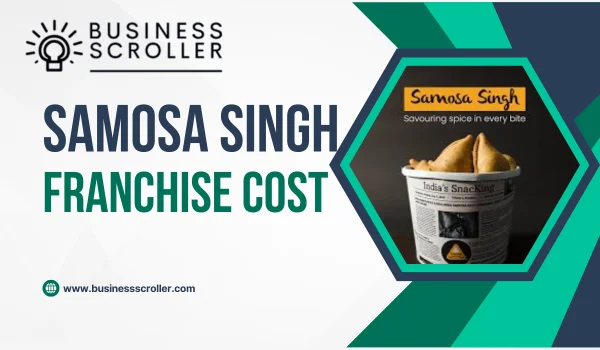Samosa Singh is a fast-food / snack-specialty brand focusing on samosas and related offerings. Founded by Shikhar Veer Singh and Nidhi Singh, it has expanded into many cities across India with dozens of outlets. It positions itself as a modern, innovative take on the snack business—with unique shapes, healthier frying, varied fillings & good brand visibility.
Key Franchise Metrics
Here’s a table summarizing the public estimates for Samosa Singh franchise:
| Feature | Detail / Estimate |
| Number of outlets (approx.) | 40-50+ outlets in ~25+ cities. |
| Minimum area required | ~ 300-1,200 sq.ft depending on format and location. |
| Franchise fee (one-time) | ₹3-8 lakh + GST in most estimates. |
| Total investment including setup, inventory, working capital etc. | ₹15-25 lakh in many cases; some sources quote up to ₹35 lakh for larger or more premium/ high-rent locations. |
| Royalty / ongoing percentage | 5-7% of gross sales (some say “5-8%”) is typical. |
| Profit margin (net) estimate | Many sources give ~15-25% net, with gross margins being much higher. |
| Payback / ROI period | 12-24 months (1-2 years), depending upon location, footfall & cost discipline. |
| Franchise agreement term | ~ 10 years, often renewable. |
Detailed investment components

To better understand the “₹15-25 lakh (or more)” range, here’s what your money will go toward (public & modelled estimates):
| Component | Typical Cost Estimate | Factors that push cost up/down |
| Franchise / brand license fee | ₹3-8 lakh + GST | Higher in metro / premium malls; lower in smaller towns or secondary locations. |
| Store fit-out / interiors, signage, furniture etc. | ₹4-8 lakh | Quality of materials, design, location (mall vs street vs food court). |
| Kitchen / cooking / food-prep equipment & machinery | ₹4-10 lakh | Quality, capacity, whether heavy equipment is needed. |
| Inventory & supplies (ingredients, packaging) | ₹1-3 lakh | Initial stocking cost; if supply chain is centralized, might get bulk discounts. |
| Working capital (staff salaries, utilities, rent buffer) | ₹2-4 lakh or more | Size of the store, labour cost in city, rental cost, lead time until revenue stabilizes. |
| Marketing / launch costs | Some sources estimate ₹50,000-₹2 lakh (locally) depending on how aggressive the opening is. | |
| Licensing, permits & legal documentation | Non-negligible, though less documented in public sources, depending on local municipal, food safety, health licenses. |
Revenue & Profit / Margins: What to Expect
Based on the data publicly available & case studies of similar snack / quick service food franchises, here are expected revenue and margin metrics for a typical Samosa Singh outlet:
- Daily / Monthly Sales: Depending on location (mall vs high street vs food court street) monthly revenues can range from ₹3-8 lakh or more in mid-sized cities. Higher in metros. Some sources estimate average of ~ ₹4.2 lakh in monthly sales in certain outlets.
- Gross Margin: On food business like this, gross margins can be fairly high (50-70% in many snack/water/tea/samosa business) before operating expenses. Some sources say gross margin ~70%.
- Net Margin: After rent, labour, utilities, royalty etc., realistic net margin tends to be ~ 15-25% depending on how well costs are controlled.
- Profitability & ROI: With good location & execution, many sources estimate breakeven or return on investment in 12-24 months (1-2 years).
Eligibility Criteria: What Samosa Singh looks for (or what you need to have)
From franchising norms (as per the public sources) plus logic based on food retail, to be eligible you typically need:
- Investment readiness: Have the required capital (₹15-25 lakh or more depending on location) ready or access to finance.
- Premises / space: Typically ~300-1,200 sq.ft for many outlets; minimum often ~300 sq.ft. You will need to secure a lease/rental agreement in a suitable location. Rent costs / deposit vary significantly by city and location.
- Food safety / licences: Regulatory compliance — FSSAI licence (or equivalent local food safety licences), GST registration, business trade licenses as required.
- Operational capacity / staff: You will need to hire staff (some sources say 5-8 staff initially), manage inventory, quality, customer service. Training is usually provided by Samosa Singh.
- Brand standards compliance: You’ll need to adhere to Samosa Singh’s quality, interior & branding guidelines, service norms, etc.
- Experience: Prior retail / food business experience is helpful but not always mandatory. However, managing a food outlet has unique challenges (labor, hygiene, waste, peak hours).
Steps to Apply for a Samosa Singh Franchise
Here’s a probable roadmap based on what’s shared publicly and what franchise business norms suggest. Actual process may have variations.
- Research & Decide Format
Understand whether you want a full dine-in/outlet, a small kiosk / food court, or perhaps a delivery-first model. Size, bearing of rent, footfall will matter a lot. - Estimate Local Costs
Find space, get quotes for rent, interior works, equipment costs, staffing, utilities in your target city. Build a financial model: what daily / monthly sales you’ll need to cover costs. - Reach Out to Samosa Singh
Visit their official website (samosasingh.com) and look for a “Franchise”, “Become a Partner”, or “Contact Us” section. There will often be a franchise enquiry form. - Submit Application / Franchise Proposal
Supply your profile (background, finance capacity), proposed location details (address, size, rent), your proposed format/outlet size, and investment plan. - Site Evaluation / Feasibility Review
If the proposal is good, Samosa Singh’s team likely does a site visit / feasibility study to check catchment, competition, rent stability, customer traffic etc. - Receive Term Sheet / Agreement
You will get details: what fees are one-time (franchise fee), recurring costs (royalty, marketing), expected support (training, supplies, marketing). Be sure to ask: layout requirements, equipment lists, food supply sources, quality benchmarks. - Fit-out, Equip, Hire & Train
Once agreement is signed, you will set up the outlet: interior, furniture, kitchen & cooking equipment, hire staff, get licenses, etc. Usually, the franchisor helps with training, sometimes with procurement for standard supplies or preferred vendors. - Launch & Marketing Support
Grand opening promotions, local advertising; sometimes digital / social media support from the brand. Need to ensure you tailor local marketing as well. - Operate & Monitor
Keep track of sales, manage inventory well (avoid wastage), quality, customer satisfaction. Royalty payments and financial reporting as per franchise agreement.
Official Contact Details
For serious enquiry, you’ll want to contact Samosa Singh directly. Here are the contacts that public sources list:
- Franchise Enquiry / Phone Number: +91 8949793519
- Official Website: https://www.samosasingh.com/
- Other possible contact via franchise info pages (though not always official email): Samosa Singh doesn’t clearly publish an email (in many franchise info pages) explicitly for franchise queries — some mention phone only. Always verify on the official website.
If writing, your email should include: proposed location (city, street or mall), size of space, background/experience, approximate investment budget, and request the franchise brochure / terms.
Financial Example / Sample P&L (Hypothetical)
Here’s a rough illustrative financial model for a mid-sized Samosa Singh outlet in a Tier-2 city:
| Parameter | Estimate |
| Space / Rental (300 sq.ft) | ₹30,000/month rent |
| Monthly fixed costs (utilities, staff salaries (5-8 people), maintenance etc.) | ₹80,000 – ₹1,20,000 |
| Cost of goods sold (ingredients, packaging, oil etc.) ~ 30-35% of sales | If sales ₹5,00,000 → COGS ~ ₹1,50,000-₹1,75,000 |
| Royalty (say 6%) on gross sales | ~ ₹30,000 |
| Miscellaneous (marketing, waste, minor repairs) | ₹10,000-₹20,000 |
| Revenue target to break even | Probably ~ ₹4,50,000-₹5,50,000/month in this city, depending on rent |
| Net profit-after-costs when sales reach ₹7-8 lakh/month | Possibly ~ ₹1,00,000-₹2,00,000 after all overheads; margin ~15-25% (depending on scale and cost control) |
With these numbers, payback on an investment of ~ ₹20-25 lakh might happen in 18-24 months if the outlet performs well. In very good locations (mall/high footfall street), payback could be faster; in weaker locations might take longer.
Key Risks / What to Watch Out For
- Location & Rent Escalations: High rents eat into margins. Locations with good traffic are expensive.
- Competition & Customer Preferences: Lots of snack / quick-bite brands; taste, pricing, hygiene must be top notch.
- Supply & Cost Volatility: Ingredient costs (oil, flour, spices etc.) fluctuate. Must have hedges or reliable supply chain.
- Labour Costs & Hygiene: Staff availability & maintaining hygiene standards impact reputation.
- Royalty & Recurring Charges: Make sure you fully understand ongoing fees (5-7% etc) as they reduce net profit.
Final Thoughts
Samosa Singh appears to be a promising snack-franchise opportunity in India for entrepreneurs with appetite for food business & an ability to manage operations. Key positives: well-known brand in snack domain, relatively moderate investment vs full restaurant formats, good margins if you control costs. Less attractive if location is weak or rent too high.
Before committing, ensure you get the official, current franchise brochure from samosasingh.com and verify all terms (fees, royalty, required standards). Also, visit existing outlets, talk to existing franchisees if possible, build your own detailed cost/revenue model for your city/area.

Shashi Kant is the Founder and Editor of BusinessScroller.com, a leading platform for business insights, finance trends, and industry analysis. With a passion for journalism and expertise in business reporting, he curates well-researched content on market strategies, startups, and corporate success stories. His vision is to provide valuable information that empowers entrepreneurs and professionals. Under his leadership, BusinessScroller.com has grown into a trusted source for in-depth articles, customer care guides, and financial expertise.


